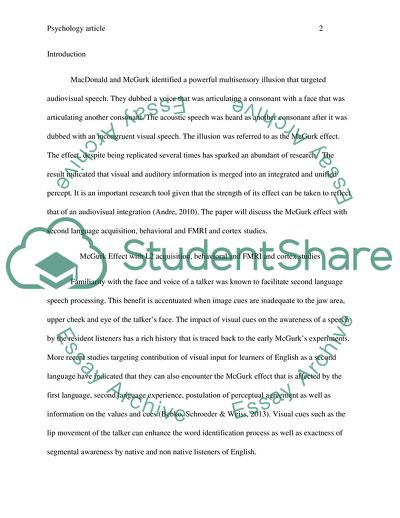Cite this document
(Mcgurk Effect with L2 Acquisition, Behavioral, and FMRI and Cortex Studies Essay Example | Topics and Well Written Essays - 2000 words, n.d.)
Mcgurk Effect with L2 Acquisition, Behavioral, and FMRI and Cortex Studies Essay Example | Topics and Well Written Essays - 2000 words. https://studentshare.org/psychology/1868171-mcgurk-effect-with-l2-acqusition-behavioral-and-fmri-and-cortex-studies
Mcgurk Effect with L2 Acquisition, Behavioral, and FMRI and Cortex Studies Essay Example | Topics and Well Written Essays - 2000 words. https://studentshare.org/psychology/1868171-mcgurk-effect-with-l2-acqusition-behavioral-and-fmri-and-cortex-studies
(Mcgurk Effect With L2 Acquisition, Behavioral, and FMRI and Cortex Studies Essay Example | Topics and Well Written Essays - 2000 Words)
Mcgurk Effect With L2 Acquisition, Behavioral, and FMRI and Cortex Studies Essay Example | Topics and Well Written Essays - 2000 Words. https://studentshare.org/psychology/1868171-mcgurk-effect-with-l2-acqusition-behavioral-and-fmri-and-cortex-studies.
Mcgurk Effect With L2 Acquisition, Behavioral, and FMRI and Cortex Studies Essay Example | Topics and Well Written Essays - 2000 Words. https://studentshare.org/psychology/1868171-mcgurk-effect-with-l2-acqusition-behavioral-and-fmri-and-cortex-studies.
“Mcgurk Effect With L2 Acquisition, Behavioral, and FMRI and Cortex Studies Essay Example | Topics and Well Written Essays - 2000 Words”. https://studentshare.org/psychology/1868171-mcgurk-effect-with-l2-acqusition-behavioral-and-fmri-and-cortex-studies.


